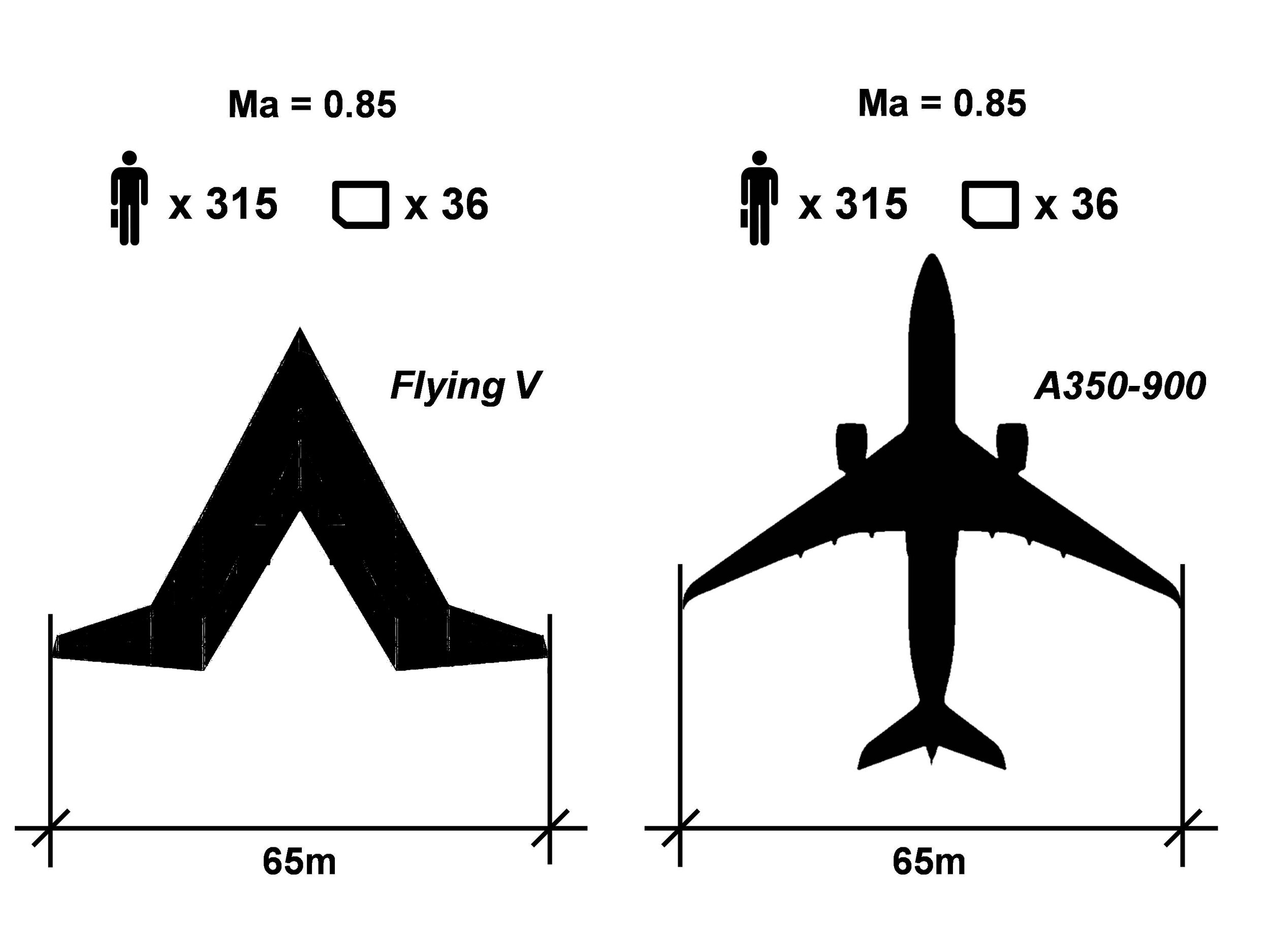The Flying V
2013 - 2016
This project is continued at TU Delft in collaboration with several partners. More information
In this work, an idea for a commercial passenger aircraft was derived. Preliminary estimations indicate potential benefits of the new concept called the “Flying V” over the A350-900 reference aircraft: 10% higher L/D, 2% lower mass, a compact and simple configuration (no high-lift devices, no fairings, straight lines), and low noise (shielding of the engines from the ground).
A streamwise cut through the oblique pressurized section of the Flying V is flat and elliptical and thus it fits efficiently into airfoils. This leads to both structural and aerodynamic efficiency. A patent application for the concept was filed by Airbus [1].
Remarkable is also the elliptical lift distribution of the stable design using only moderate wing twist and no reflexed camber lines. A radio controlled model of the Flying V was built to demonstrate these aerodynamic characteristics and support estimations and simulations which were made in this work.
The first flight of the glider version of the demonstrator model took place in Berlin, Germany on February 28, 2014:
The first flight of the powered version of the demonstrator model was in Hamburg, Germany on April 13, 2014:
The pilot of the first powered flight was Simon Hinsch.
Presentation and flight videos:
For a full length video presentation with more details on the Flying V design see this news post from February 4, 2015.
The video highlights, including flight videos of the first demonstrator, can be watched in this video:
Early news posts on the Flying V project:
Early events related to the Flying V project:
Recognition of the Flying V project:
First prize of the Royal Aeronautical Society at the Young Researcher Competition at Aerodays2015 in London, UK.
Early publications
Presentation (February 2015):
The Flying V: A new aircraft configuration
J. Benad
Presentation, Seminar für Mechanik, Technische Universität Berlin, 2015
Report (March 2015):
Design of a commercial aircraft for high-subsonic speed as a flying wing configuration
J. Benad
Technical report, Airbus, 2015
Paper (September 2015):
The Flying V - A new Aircraft Configuration for Commercial Passenger Transport
J. Benad
Deutscher Luft- und Raumfahrtkongress, Rostock, 2015
DOI: 10.25967/370094 URN: urn:nbn:de:101:1-201511275089
The Flying V is currently being researched further at universities and in the aerospace industry.
Further development of the Flying V at the TU Delft
Mentions of the Flying V project:
2015
2019
Deutschlandfunk Nova (German)
de Volkskrant (Dutch)
E Vesti (Russian)
Flugrevue (German)
Huanqiu (Chinese)
manager magazin (German)
MegaAviation on Instagram
NTV (German)
PM Wissen (German)
RTL XL (Dutch)
SiencePost (French)
tagesschau.de (German)
The Asahi Shimbun (Japanese)
Trouw (Dutch)
TU Delft on LinkedIn
TU intern (German)
ZDF (German)
2020
de Volkskrant (Dutch)
Flugrevue (German)
Henri Werij on LinkedIn
Kanye West on Twitter
Märkische Oderzeitung (German)
Press conference by TU Delft / KLM / Airbus
The origins of the Flying V (LinkedIn)
TU intern (German)
Video by AmazingViz
Video by Tinie Lam
Hydrogen FV (artist impression)
Tagesschau (German)
More information:
If you have questions about the project or other enquiries just contact me via e-mail.
[1] - J. Benad, “Luftfahrzeug”. DE102014201040A1, Applicant: Airbus Operations GmbH, 2014.










